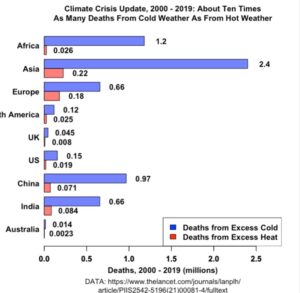
by Steve Haner
No more will Virginians have to suffer through hot summer days without the active intervention of Big Government. Virginia’s Senate Democrats are proudly advancing legislation to demand state government develop a comprehensive statewide heat emergency response plan, and then seek to impose its leadership by “coordinating” with other state agencies and local governments.
“Extreme heat kills more Americans on average than any other weather-related hazard,” claimed Senator Ghazala Hashmi, D-Richmond, in a Tweet announcing the passage of her Senate Bill 936 on Thursday. The idea now goes to the House of Delegates.
First, the claim is demonstrably false, as plenty of solid data show that deaths from cold far exceed deaths from heat. More on that in a moment.
Second, the solution to the problem (not rocket science) is called air conditioning, and Hashmi is one of the more extreme of the climate warriors seeking to drive up the cost of the electricity that runs those air conditioners. Her vision of a wind-solar-battery powered grid is already causing energy reliability problems during California heat waves.
In its fiscal analysis, the Virginia Department of Emergency Management reported it would need two additional employees to get all this done by this coming November, as the bill instructs. But the bill has also cleared the Senate Finance and Appropriations Committee, so the money will probably appear in its budget next month.
One element of the plan will be developing “public cooling spaces.” The expense for that was not estimated. The good news is that those same spaces could be used during bitter cold spells, far more dangerous, which will also be times when the coming higher energy prices leave many Virginians tempted to go without. If the state is honest about doing that right, natural gas will provide the most reliable heat in those public shelters.

The claim that “climate change” is making long heat spells longer and more common is a key part of the media fear narrative. It is false. The actual record in Virginia is quite clear that there is no indication that very hot days are increasing. We have always gotten quite a few days above 90 degrees, some years more than others.
You can eyeball the attached chart and see there is a fairly steady pattern. The data which indicate rising average temperatures is largely driven by an increase in the daily low readings, not the daily highs. The daily low readings in turn are often influenced by human development causing heat sinks near the measurement locations. Somehow all that brick and concrete and running jet engines at airports never get accounted for in the fear porn.

The claim that excess heat is the deadliest natural weather phenomenon is even easier to disprove, with one of the most cited data sets published recently by the British medical journal Lancet. Again, I’ve included a copy of a table. Cold kills about ten times more people than heat. Lancet, by the way, is overall neck deep in climate catastrophism run amok. But this data is indisputable.
If the General Assembly in its wisdom thinks this is a job for state government, if Governor Glenn Youngkin (R) agrees, at least amend the bill to deal with both extreme heat and cold. Both are real problems when they happen, and fatal to some who lack or can’t afford heat or AC.
We already have public and private shelters. The federal and state governments already distribute billions in dollars for annual heating and cooling grants, with private funds available, too. The federal and state governments already spend more billions on supposedly weatherizing or insulating housing stocks. But, sure, pretend there is suddenly some new problem previously ignored that Hashmi has now solved.
The climate catastrophe narrative is the only new element here, and the purpose of the bill is to provide another platform to spread a false but politically useful message.

Leave a Reply
You must be logged in to post a comment.